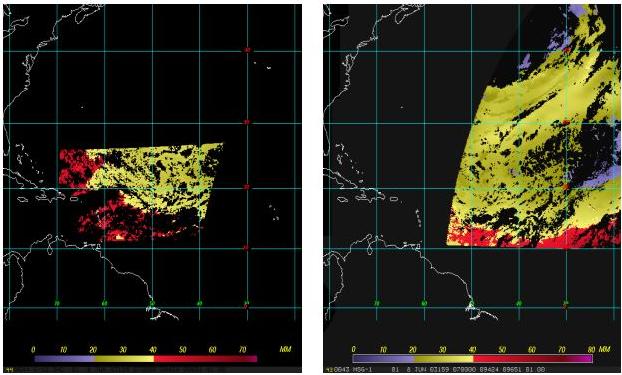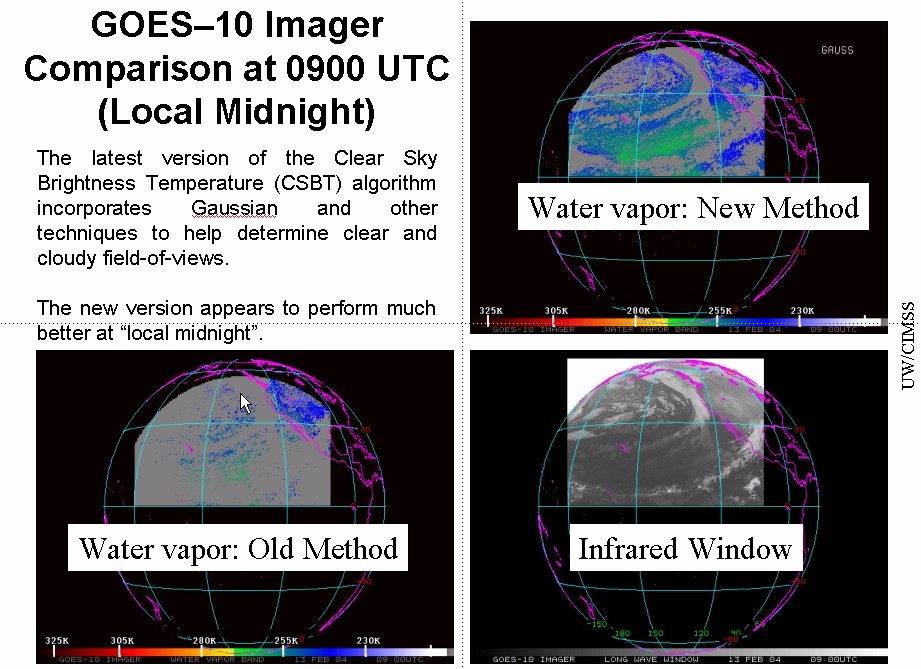 |
CIMSS-NOAA Weekly Report
[ Archive ] |
 |
ASPB AND CIMSS WEEKLY HIGHLIGHTS FOR THE WEEK ENDING FEBRUARY 27, 2004
IN THE PRESS:
ITEMS FOR THE ADMINISTRATOR:
ITEMS FOR THE ASSISTANT ADMINISTRATOR:
ITEMS FOR THE OFFICE DIRECTOR, ORA:
Japan Meteological Agency Report Positive
Impact of Polar Winds: Masahiro Kazumori of the Japan
Meteorological Agency (JMA) reported that the Moderate Resolution
Imaging Spectroradiometer (MODIS) polar winds produce a positive impact
on numerical weather forecasts. The JMA global 3D-Var data
assimilation system was used;
the experiment was done for January
2004. The assimilation experiment demonstrated a positive impact of the MODIS polar winds on
short-range forecasts, particularly for the northern hemisphere.
Forecast improvement was
quantified in terms of geopotential height forecast accuracy. (J. Key, E/RA2,
608-263-2605, D. Santek,
CIMSS,
608-263-7410, C. Velden,
CIMSS,
608-262-9168)
Participation in FLAMBE Investigator Meeting
at NRL-Monterey: On February 24 and 25, E. Prins and C.
Schmidt attended the FLAMBE (Fire Locating And Mapping of Burning
Emissions) investigators meeting at the Naval Research Laboratory in
Monterey, CA. Discussions focused on data assimilation research
plans and applications for the next three years. FLAMBE is
a joint Navy, NASA (National Aeronautics and Space Administration), and
NOAA (National Oceanic and Atmospheric Administration) project funded
by the NASA Earth System Science Enterprise Interdisciplinary Science
program. FLAMBE represents one of the first efforts to track and
predict biomass burning loading and transport in real-time using the
Geostationary Operational Environmental Satellite (GOES) Wildfire
Automated Biomass Burning Algorithm (WF_ABBA) fire products as input to
the Navy Aerosol Analysis and Prediction System (NAAPS) and has
applications in air quality, visibility, and regional radiative balance
studies. (E. Prins,
E/RA2, 530-271-2256, C. Schmidt, CIMSS, 608-262-7973)
CIMSS Scientist Visits EUMETSAT: Kathleen
Strabala
spent four weeks collaborating with Dr. Marianne Koenig at the European
Organisation for the Exploitation of Meteorological Satellites
(EUMETSAT) in Darmstadt, Germany, October 27 - November 21,
2003. During that
time, knowledge of Geostationary Operational Environmental Satellite
(GOES) sounder depiction of atmospheric
stability was transferred to Dr. Koenig, while the improved
capabilities of Meteosat Second Generation (MSG) (e.g., high spatial,
temporal and spectral
resolution) were investigated as applicable to the future Advanced
Baseline Sounder (ABI) instrument. A validation study of MSG
stability products was undertaken that consisted of comparisons of
Total Precipitable Water (TPW) and Lifted Index (LI) retrievals with
the GOES Sounder and polar orbiting Moderate Resolution Imaging
Spectroradiometer (MODIS) data. Overall, the
comparisons for TPW were similar,
while the comparisons of LI from MODIS seemed less favorable. The
evolution of cloud phase was studied with MSG, which allows for the
first ever high temporal resolution investigation of infrared cloud
phase from geostationary orbit. ABI will contain similar infrared
channels needed to determine phase. (K. Strabala, CIMSS,
608-263-8752)
 (Click image to enlarge)
(Click image to enlarge)
Figure caption: Side by side comparison of GOES 12 Sounder TPW from
07:20 UTC 8 June 2003 (left) and MSG TPW from 07:00 UTC 8 June 2003
(right).
ITEMS FOR THE DIVISION CHIEF, ARAD
Experimental Version of Clear Sky Brightness
Temperature Imagery on
the Web: A new version of the Clear Sky Brightness Temperature
(CSBT)
product is now on the web, and is displayed in a full disc view
(http://cimss.ssec.wisc.edu/goes/realtime/anicsbt_g12.html)
in addition to a high resolution aspect
(http://cimss.ssec.wisc.edu/goes/realtime/anicsbt_g10_qc.html).
This product is based on radiances from the Geostationary Operational
Environmental Satellite (GOES) Imager, and the latest version of the
CSBT
algorithm incorporates cloud masking techniques based on gaussian
principles. Impact is most notable at local midnight for the GOES-10
and -12 satellites. The National
Center for Environmental Prediction (NCEP) will use these results for
weather prediction impact studies. (J. Jung, CIMSS, T. Schreiner,
CIMSS,
608-263-6754, T. Schmit,
E/RA2,
608-263-0291)
 (Click image to enlarge)
(Click image to enlarge)
Seminars on ABI given at NSMC: Jun Li visited
National Satellite
Meteorological Center (NSMC) in Beijing and gave a seminar "Fast
cloud radiative transfer modeling for IR data and its application"
on Febuary13, 2004. J. Li also gave an invited talk
"Introduction on the Advanced Baseline Imager (ABI) on the next
generation of Geostationary Operational Environmental Satellite
(GOES-R)" at the NSMC's annual meeting on February 20,
2004. (J. Li, CIMSS,
608-262-3755)
Abstracts Submitted to the Third GOES-R Users'
Conference: Six abstracts were submitted to the Third
Geostationary Operational Environmental Satellite (GOES) -R Users'
Conference scheduled to take place May 10-13, 2004 in Broomfield,
Colorado:
"Simulation of the spectral bands on the Advanced Baseline Imager
(ABI)" by M. Gunshor, T.J. Schmit, and K. Karnauskas. The
presentation will focus on current activities at the Cooperative
Institute for Meteorological Satellite Studies (CIMSS) simulating ABI
bands in preparation for GOES-R. CIMSS has created mock spectral
response functions for ABI bands (available to the user community at ftp://ftp.ssec.wisc.edu/ABI/SRF)
and used these to create transmittance coefficients for use in a fast
forward model and generated weighting functions for the infrared
bands. Simulated ABI images are created from direct broadcast
MODerate-resolution Imaging Spectroradiometer (MODIS) and Atmospheric
InfraRed Sounder (AIRS) data collected at the University of Wisconsin
and posted to the World Wide Web in near real-time. (http://cimss.ssec.wisc.edu/goes/abi/modis_broadcast/animodis.html,
http://cimss.ssec.wisc.edu/goes/abi/airs_broadcast/aniairs.html)
(M. Gunshor, CIMSS,
608-263-1146, T. Schmit,
E/RA2,
608-263-0291)
"Using GOES-R to help
fulfill NOAA's Mission Goals" by T.J. Schmit, W. P. Menzel, J. Gurka,
and J. Li. The presentation
will highlight some of the many ways that information from the GOES-R
series will help meet NOAA's mission goals. (T. Schmit, E/RA2,
608-263-0291, J. Li, CIMSS,
608-262-3755)
"Using GOES-R to
Help Monitor SO2" by A.J. Schreiner, T.J. Schmit, J. Li, G.
Ellrod, M. Gunshor, and K. Karnauskas. The presentation will focus
on
the potential for the Advanced Baseline Imager (ABI) and the
Hyperspectral Environmental Suite (HES) instruments to detect and
monitor
atmospheric SO2 and consequently volcanic activity. (T. Schreiner,
CIMSS,
608-263-6754, T. Schmit,
E/RA2,
608-263-0291, J. Li, CIMSS,
608-262-3755, M. Gunshor,
CIMSS,
608-263-1146)
"Applications of the Advanced Baseline Imager for Fire Detection and
Characterization" by C. Schmidt and E. Prins. The presentation
will discuss applications of the GOES Wildfire Automated Biomass
Burning Algorithm (WF_ABBA) to the Advanced Baseline Imager (ABI) on
GOES-R and beyond, which will enable continued analysis of fire
activity throughout the Western Hemisphere with significant
improvements in fire detection and sub-pixel fire
characterization. Simulations of enhanced GOES ABI fire
monitoring capabilities will be demonstrated using MODerate-resolution
Imaging Spectroradiometer (MODIS) observations of fires in the Western
U.S.
(C. Schmidt, CIMSS,
608-262-7973, E. Prins,
E/RA2,
530-271-2256)
"Lossless Data
Compression Studies for NOAA Hyperspectral Environmental Suite" by
B. Huang, H-L Huang,
A. Ahuja, H. Chen, T. Schmit and R.. Heymann. (B. Huang, CIMSS,
608-265-2231)
"Lossy Data Compression and Retrieval
Impact Studies for NOAA Hyperspectral
Environmental
Suite" by B. Huang,
A. Ahuja, H-L Huang,
T. Schmit and R.. Heymann. (B. Huang, CIMSS,
608-265-2231)
Two journal papers accepted on hyperspectral data
compression: A paper titled "Lossless compression of 3D
hyperspectral sounding data using context-based adaptive lossless image
codec with bias-adjusted reordering" was accepted for publication in Optical
Engineering. Another paper titled "Improvements
to predictor-based methods in lossless compression of 3D hyperspectral
sounding data via higher moment statistics" will appear in the next
issue of
WSEAS Transactions on Electronics. The authors of both papers
are B.
Huang, A. Ahuja,
H-L Huang,T. Schmit and R.
Heymann. (B.
Huang, CIMSS,
608-265-2231).
IHC Oral Presentation: A presentation was
developed with J.
Gurka
for next week's Inter-department Hurricane Conference (IHC). The title
is
"The Geostationary Operational Environmental Satellite (GOES)-R
Series: Plans for a New Era in Hurricane Monitoring." The authors
are J. Gurka and T. J. Schmit. The presentation (to be given by
J.
Gurka) will be March 2, 2004 in Charleston, SC. (T. Schmit, E/RA2,
608-263-0291)
Manuscript Reviewed: R. Aune reviewed a paper
for Monthly Weather Review that utilized remotely-sensed
products to assess long term precipitation budgets over a limited area.
(R. Aune, E/RA2,
608-262-1071)
VISITORS:
NEXT WEEK:
LOOKING AHEAD:
Archived Weeklies Page



